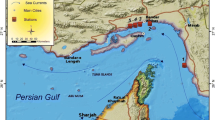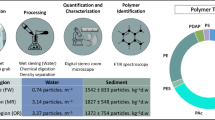Abstract
Microplastics (MPs) (<5 mm) are emerging pollutants that have attracted widespread environmental concerns about their negative effects on the marine ecosystems. The harbor area of Sidi Youssef in Kerkennah Islands is threatened by the abandoned plastic fishing gears or their leftovers which affect fish stocks and consequently pose a serious threat to the marine environment. In this study, microplastic pollution in surface sediments from 20 stations was investigated. The average abundance of (MPs) was 611 ± 514 items/m2. Fibers and fragments were dominant in most sites (94%), followed by granules, foams, and tubes. MPs < 500 μm accounted for more than half of the total MPs while small MPs < 1 mm accounted for 97%. White and transparent MPs were more common with 87.8% than of other colors. Based on the identification by FTIR-ATR, polypropylene (PP) and polyethylene (PE) were the main polymer types found in sediments. These results highlighted the widespread distribution of MPs and will provide our understanding of the environmental risks posed by MPs to marine ecosystems.
Access provided by Autonomous University of Puebla. Download conference paper PDF
Similar content being viewed by others
Keywords
1 Introduction
Microplastics (MPs), defined as plastic particles less than 5 mm in length, have been receiving increasing attention as unfortunate major problems for allowing pollutants to cross the ground and affect wildlife and groundwater. MPs occurrence and distribution have been documented in remote areas worldwide including sediments, surface water, island lakes, and estuarine, coast and marine organisms [11]. The Mediterranean sea which has become concerned by this issue is exposed to high anthropogenic pressures by dense habitat, shipping canal, and strong tourism activities and is considered as a sink for MPs accumulation in sediments, in Sweden, Germany, the Netherlands, Belgium, Tunisia, and floating in seawater, in Malta, Italy, Nile deep-sea fan, and Greece [6]. The widespread distribution and occurrence of MPs have been surveyed in sediments as the main focus for the final destination of most MPs categories with diverse sizes [10]. The harbor area of Sidi Youssef in Kerkennah Islands is characterized by specific anthropogenic pressures linked to fishing activities. Abandoned or lost fishing gear affects fish stocks and poses a threat to the marine environment. Indeed, between traditional fishing and illegal fishing, hybrid methods have developed in the Kerkennah Islands. The “gargoulettes” used for catching octopus are now made of concrete, while the plastic traps often replace the palm traps. Plastic waste that is not collected on the earth ends up in the oceans. There, they break down into increasingly tiny fragments and turn into microplastic particles. Only a few investigations have been conducted on the MPs distribution in coastal areas of Tunisia [1,2,3].
Yet, no data are available on the distribution and occurrence of microplastics pollution in the Kerkennah Islands, Sfax (Tunisia). These islands are one of the most touristic regions and urbanized industrially. In this study, microplastics collected from 20 sampling points at the Sidi Youssef harbor were set up for the first time. This overview of the used method from field sampling to laboratory analysis will provide the preliminary data on abundance, type, and composition of microplastics in Sidi Youssef harbor.
2 Materials and Methods
Sediment samples were collected from Sidi Youssef (SY) harbor (34°39′23.56″ N, 10°58′18.31″ E), on March 23rd, 2018, during dredging activities. A total of 20 samples were collected using a 50 m regular grid pattern, resulting in 2 parallel lines and one perpendicular line to the waterline as indicated in Fig. 1. The top of 3–5 cm of sediments was sliced off from 0.25 to 0.25 m2 using a stainless spatula and scooped in precleaned glass jars (250 g), then transported rapidly to the laboratory, where they were frozen at 4 °C. Sediments were homogenized and dried at 40 °C for 3–5 days. They were fractioned through a cascade of stainless-steel sieves of 5-, 2-, and 1-mm mesh. Because the sediments were between fine and medium sand, they were divided into two classes < 1 and 1–5 mm. In each class, plastics were excluded from the non-plastics by visual sorting (1–5 mm) and density separation (NaCl). The smallest size class (<1 mm) was suspended in a high saline concentration of NaCl in order to extract the MPs particles following the method described by Mathalon and Hill [9].
This method consists of dispersed dried sediments in high saline solution (120 g (NaCl)/L H2O). They were vigorously shaken for 15 min and settled for 2 h. The supernatant with the extracted floating particles from sediments was filtered (Sciences PTFE Membrane Filters 47, 0.45 mm) and then washed with distilled water to remove any remaining salts. These fractions were dried at 60 °C for 2 h before the digestion process. This was performed using 10% KOH solution as indicated by Lusher et al. [7]. MPs were rinsed with 1 mL of 80% (v/v) ethanol and visualized under an optical microscope (COFEMO, CFM-7045 B2,) using the Fluorescence staining method described by Maes et al. [8]. The plastic particles were sorted based on morphology: foams, tubes, granules/pellets, fragments, and fibers. Finally, all particles were counted and photographed before identification by FTIR Spectroscopy‒Attenuated Total Reflectance (ATR). During all the aforementioned procedures, 100% cotton lab coats were used, in order to minimize any cross contamination, due to fibers released from clothing.
3 Results
In the studied harbor, the sediments were relatively fine and medium sandy and completely full by small shells and other marine impurities. Indeed, it was difficult to conduct the separation of all tiny MPs. Data obtained showed that Sidi Youssef harbor is contaminated by 611 items of plastic debris across 20 sampling points. Around 97% of pieces are recognized to be MPs (<1 mm) with the one of size between 1 and 5 mm represented less than 3% as illustrated in Fig. 2. Within the three lines, the highest MPs concentrations were generally found in the second line “L2” with an average of 275 ± 0,896 items/m2 followed by the line “L1” with 218 ± 0,748 items/m2 and then the line of dredging zone “L3” with 118 items/m2. It is important to note that a clear increase of small size particles < 1 mm was observed. This is most probably due to the degradation of larger plastic items (1–5 mm). These can occur during inter- and intra-particle collisions [4], due to UV radiation, and mechanical and/or biological degradation processes [5, 13].
With respect to shape, fragments and fibers were the most abundant in all samples. Colored microparticles were dominant among the microplastic particles, followed by transparent items. For all samples, PP and PE were found to be the most components of polymers of plastic marine debris.
4 Discussion
Microplastics are known to absorb various harmful pollutants having significant impacts on human health and the environment. However, their distribution, abundance, and the attached organisms along harbors are not well understood. This is the first report on the presence of microparticle community on MPs in Sfax (Tunisia). From this study, fragment and fiber items were found to be the most abundant type of MPs identified in all sediment samples. The abundance of both pieces was the greatest as the coastal activities which include fishing practices, aqua tourism, and marine industries. These activities are the sources of MPs (mainly composed of PP and PE) pollution in the marine ecosystem. The distribution of MPs has been observed to be dependent on environmental and anthropogenic factors. For instance, wind direction and tidal currents are the main factor forces behind their spatial distribution. Indeed, Zhao et al. [11] postulated that there would be a greater accumulation of MPs at downwind sites. In the present study, the dominant size of MPs is less than 1 mm increasing the chances of trophic transfer to marine predators through their ingestion of low-level food web organisms [12]. It is therefore essential to assess the risks posed by increasing item numbers of small size MPs in the marine environments. Based on FTIR-ATR identification, PP and PE were found to be the most common floating polymers in the present study. Indeed, PP and PE are the most used polymer types, which are commonly found in consumer products (e.g., plastic traps, fishnet, plastic bags, bottles, caps, films, and containers) and are likely derived from the breakdown of larger debris [12]. Alternatively, these types are also used in personal care and cosmetic products (PCCPs), such as abrasive, for film-forming, viscosity controlling, and as binder for powders [12].
5 Conclusion
In the present study, we reported for the first time the MPs pollution in the harbor of Sidi Youssef in the island of Kerkennah. The results revealed that the 20 sampling points are vulnerable to MPs form representing a potential risk for human health that may be entering the food chain through ingested marine organisms. As the abundance of microplastics in the marine environment increases, further studies are planned to quantify their presence in all Tunisian coasts, biota and to assess their toxicological effects.
References
Abidli, S., Toumi, H., Lahbib, Y., Trigui El Menif, N.: The first evaluation of microplastics in sediments from the complex Lagoon-Channel of Bizerte (northern Tunisia). Water Air Soil Pollut. 228, 262 (2017)
Abidli, S., Antunes, J.C., Ferreira, J.L., Lahbib, Y., Sobral, P., El Menif, N.T.: Microplastics in sediments from the littoral zone of the north Tunisian coast (Mediterranean Sea). Estuar., Coast. Shelf Sci. 205, 1–9 (2018). https://doi.org/https://doi.org/10.1016/j.ecss.2018.03.006
Chouchene, K., da Costa, J.P., Wali, A., Girão, A.V., Hentati, O., Durate, A.C., Rocha-Santos, T., Ksibi, M.: Microplastic pollution in the sediments of Sidi Mansour Harbor in Southeast Tunisia. Mar. Pollut. Bull. 146, 92–99 (2019)
Cooper, D.A., Corcoran, P.L.: Effects of mechanical and chemical processes on the degradation of plastic beach debris on the island of Kauai, Hawaii. Mar. Pollut. Bull. 60(5), 650–654 (2010). https://doi.org/https://doi.org/10.1016/j.marpolbul.2009.12.026.
Ding, J., Li, J., Sun, C., Jiang, F., Peng, Ju., Lingyun, Qu., Zheng, Y., He, C.: Detection of microplastics in local marine organisms using a multi-technology system. Anal. Methods 11, 78 (2019)
Lusher, A.: Microplastics in the marine environment: distribution, interactions and effects. In: Bergmann, M., Gutow, L., Klages, M. (eds.) Marine Anthropogenic Litter, pp. 245–307. Springer International Publishing, Cham (2015)
Lusher, A., Welden, N., Sobral, P., Cole, M.: Sampling, isolating and identifying microplastics ingested by fish and invertebrates. Anal. Methods 9, 1346–1360 (2017)
Maes, T., et al.: A rapid-screening approach to detect and quantify microplastics based on fluorescent tagging with Nile Red. Sci. Rep. 7, 44501 (2017). https://doi.org/10.1038/srep44501
Mathalon, A., Hill, P.: Microplastic fibers in the intertidal ecosystem surrounding Halifax Harbor. Nove Scotia. Mar. Pollut. Bull. 81, 69–79 (2014)
Wang, j., Wang, M., Ru, S., Liu, X.: High level of microplastic pollution in sediments and benthic organisms of the South Yellow Sea, china. Sci. Total. Environ. 651, 1661–1669 (2019)
Zhao, J., Ran, W., Teng, J., Liu, H., Yin, X., Cao, R., Wang, Q.: Microplastic pollution in sediments from the Bohai sea and the Yellow sea. China. Sci. Total. Environ. 640–641, 637–645 (2018)
Zhao, S., Zhu, L., Li, D.: Microplastic in three urban estuaries. China. Environ. Poll. 206, 597–604 (2015)
Zhu, L., Bai, H., Chen, B., Sun, x., Qu, K., Xia, B.: Microplastic pollution in North Yellow Sea, China: observations on occurrence, distribution and identification. Sci. Total. Environ. 636, 20–29 (2018)
Author information
Authors and Affiliations
Corresponding author
Editor information
Editors and Affiliations
Rights and permissions
Copyright information
© 2021 The Editor(s) (if applicable) and The Author(s), under exclusive license to Springer Nature Switzerland AG
About this paper
Cite this paper
Chouchene, K., Rocha-Santos, T., Ksibi, M. (2021). Microplastic (MP) Pollution in Sidi Youssef Harbor of the Kerkennah Islands, Sfax (Tunisia). In: Ksibi, M., et al. Recent Advances in Environmental Science from the Euro-Mediterranean and Surrounding Regions (2nd Edition). EMCEI 2019. Environmental Science and Engineering(). Springer, Cham. https://doi.org/10.1007/978-3-030-51210-1_326
Download citation
DOI: https://doi.org/10.1007/978-3-030-51210-1_326
Published:
Publisher Name: Springer, Cham
Print ISBN: 978-3-030-51209-5
Online ISBN: 978-3-030-51210-1
eBook Packages: Earth and Environmental ScienceEarth and Environmental Science (R0)






